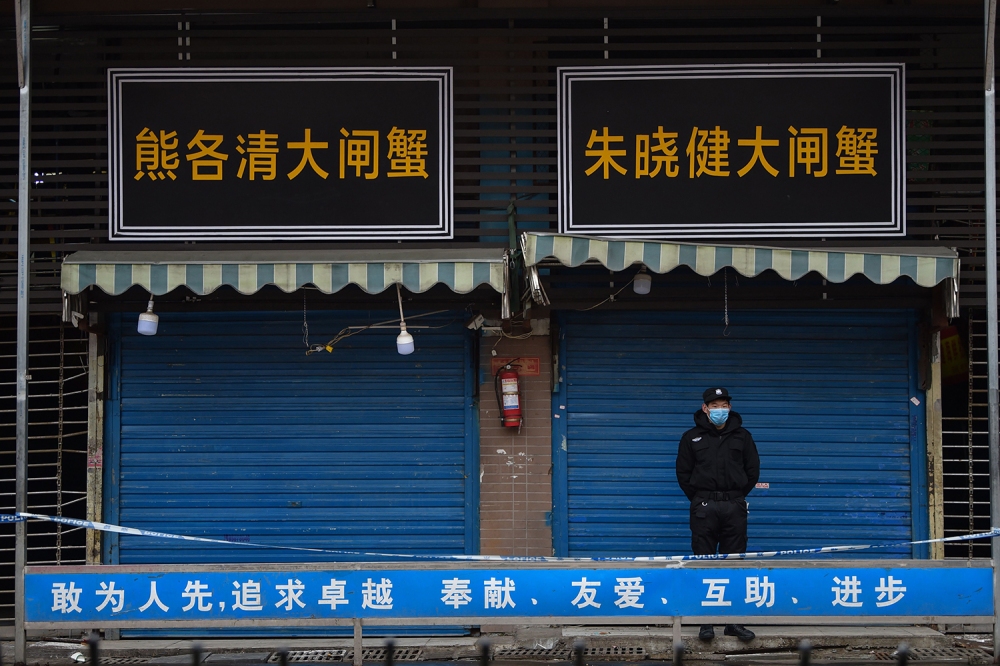Conspiracy Theories About COVID-19 Are Dangerous and Unsupported

In July 2020, the Lancet, one of the world’s premier medical journals, announced the creation of a COVID-19 “Commission” with the stated mission “to help speed up global, equitable, and lasting solutions to the pandemic.” Many of the commissioners are distinguished scientists, doctors, former politicians, or policy experts with a clear connection to the remit of a COVID-19 Commission. But the choice of chair was an unusual one. Jeffrey Sachs is a Columbia University economist with no expertise in virology, evolution, epidemiology, or public health.
Cooperation among experts in different fields is usually a positive and rewarding effort. But as a virologist specializing in host interactions with emerging viruses and an evolutionary biologist with expertise in viral pandemic origins, we find it troubling how easily Sachs has leveraged his academic celebrity to publish grave, unsubstantiated accusations under the guise of legitimate scholarship.
Sachs has consistently pushed the idea that SARS-CoV-2, the virus that causes COVID-19, was engineered in a laboratory. Michael Worobey, one of this article’s authors, has been one of the most vocal proponents of taking the idea of a lab leak seriously, proposing an influential letter published in Science that brought the hypothesis into the mainstream. It was a hypothesis worth considering, especially the version that posited a natural bat virus infecting an unsuspecting lab worker; the evidence now, however, overwhelmingly indicates the pandemic did not originate via any kind of laboratory incident.
In July 2020, the Lancet, one of the world’s premier medical journals, announced the creation of a COVID-19 “Commission” with the stated mission “to help speed up global, equitable, and lasting solutions to the pandemic.” Many of the commissioners are distinguished scientists, doctors, former politicians, or policy experts with a clear connection to the remit of a COVID-19 Commission. But the choice of chair was an unusual one. Jeffrey Sachs is a Columbia University economist with no expertise in virology, evolution, epidemiology, or public health.
Cooperation among experts in different fields is usually a positive and rewarding effort. But as a virologist specializing in host interactions with emerging viruses and an evolutionary biologist with expertise in viral pandemic origins, we find it troubling how easily Sachs has leveraged his academic celebrity to publish grave, unsubstantiated accusations under the guise of legitimate scholarship.
Sachs has consistently pushed the idea that SARS-CoV-2, the virus that causes COVID-19, was engineered in a laboratory. Michael Worobey, one of this article’s authors, has been one of the most vocal proponents of taking the idea of a lab leak seriously, proposing an influential letter published in Science that brought the hypothesis into the mainstream. It was a hypothesis worth considering, especially the version that posited a natural bat virus infecting an unsuspecting lab worker; the evidence now, however, overwhelmingly indicates the pandemic did not originate via any kind of laboratory incident.
Sachs’s increasingly speculative musing about pandemic origins culminated in a recent interview with Current Affairs, in which he directly dismissed the findings of our recent, peer-reviewed paper that established the Huanan Seafood Wholesale Market as the epicenter of the pandemic, with live animals being sold there the overwhelmingly likely conduit of the virus into humans. Instead of engaging with the evidence we used to reach this conclusion, Sachs claims that we are “creating a narrative” to avoid addressing his preferred hypothesis: The pandemic began as a result of a conspiracy between the National Institutes of Health (NIH), NIH-funded scientists, and the Wuhan Institute of Virology (WIV).
Sachs recently appeared on a podcast with notorious anti-vaccine advocate Robert F. Kennedy Jr., where he elaborated on these claims. He believes that American and Chinese scientists collaboratively conducted so-called gain of function research—or experiments to make a pathogen more transmissible and/or pathogenic—and that this may have been part of “biodefense” research funded by the U.S. National Institute of Allergy and Infectious Diseases (NIAID), which does not include biodefense as its primary focus. Kennedy insinuates that this alleged work may have been a violation of the 1972 Biological Weapons Convention (BWC), a disarmament treaty that expressly forbids the development of such agents, to which Sachs replies “You can’t make this stuff up,” going on to say “a lot of this work is around the biodefense, highly classified environment and of course that means that the transparency, the understanding of what is going on here is so much less indeed than it otherwise might have been.”
Such serious allegations should be backed up by substantive evidence. However, no such evidence is offered besides suspicions based on unfunded grant applications, speculation about NIAID director Anthony Fauci’s motives, and the notion that virologists are lying to protect their profession and research funds. To date, apart from these unfounded suspicions, the sole piece of evidence that supports a lab leak is the emergence of SARS-CoV-2 in Wuhan, China.
By contrast, the evidence consistent with a zoonotic origin, meaning infections that spread between animals and humans, is overwhelming and has since rendered the likelihood of a “lab leak”—resulting from bioweapons development or not—miniscule. Where a lab leak at the WIV might be expected to have led to the first COVID-19 cases being detected there, there were none. Instead, the majority of cases were at the largest live wildlife market in Wuhan, one of only a handful in the city with consistent sales.
Where a lab leak might lead at most to an unprecedented single arrival of a new virus into humans, instead we find a roughly 99 percent probability that SARS-CoV-2 spilled over at least twice, as with other animal spillovers, with each early lineage geographically associated with Huanan. Lab leak conspiracy theorists point to a WIV database that supposedly went offline in September 2019. But the pandemic started in October 2019 at the earliest. And so on.
These interviews and appearances continue a dangerous record of meddling and conspiratorialism on his part as head of the Lancet’s COVID-19 Commission. Although a COVID-19 “origins task force” initially included many scientists whose expertise and objectivity were praised by Sachs, it was eventually disbanded unilaterally by Sachs due to “potential conflicts of interest,” specifically connections of a minority of members to EcoHealth Alliance and WIV, two institutions accused of involvement in a “lab leak” origin of the pandemic. At the time, Sachs declared, “I just didn’t want a task force that was so clearly involved with one of the main issues of this whole search for the origins.”
Despite having no scientific expertise on the matter, Sachs authored an opinion piece in the Proceedings of the National Academy of Sciences, making the unsupported claim that this part of the viral genome, called the furin cleavage site, was “a deliberate introduction,” citing an unfunded grant proposal from researchers at EcoHealth Alliance, the University of North Carolina at Chapel Hill, and WIV, describing work that was likely never performed. Furin cleavage sites have evolved naturally in multiple coronaviruses, including two that cause the common cold.
We authored a recent opinion piece explaining how we conclusively determined that the pandemic’s epicenter was the Huanan market to a general audience in plain language, including the observation that the sole piece of evidence linking the pandemic to the WIV is that it began in Wuhan. Sachs declares our viewpoint “a lie.”
Our work comprises multiple streams of verifiable evidence that can only reasonably be explained by zoonotic emergence at the Huanan market. Sachs denigrated and dismissed it all as a “sleight of hand” intended to draw the public’s gaze away from the WIV, presumably to provide cover for virology as a profession and avoid inconvenient questions about excluding an alternative hypothesis—a well-worn lab leak talking point. This is especially remarkable given Worobey’s advocacy for exploring alternate hypotheses. Sachs advances another standard lab leak talking point: that no one has really evaluated the lab leak hypothesis. But our work could as easily have shown that the preponderance of early cases linked to the Huanan market was a mirage, or that the outbreak had a single origin, or that early spread in Wuhan was around the WIV.
Worobey was invited by Sachs in February, shortly after the preprint of our paper had posted, to appear as “one of a few outside experts” to speak about COVID-19 origins with the members of the Lancet’s COVID-19 Commission who had survived his earlier purge of members skeptical of lab leak hypotheses. Although he was initially keen to participate, Worobey’s correspondence with Sachs raised multiple red flags, including pretty standard conspiracy-minded lines from Sachs like, “NIH, it seems to me, has been evasive from the start.” Sachs had an appallingly weak grasp of the scientific work he had invited Worobey to discuss—no questions or comments indicating a reasonable, nonexpert level of comprehension of the findings or even basic, nontechnical details of Sachs having read his paper.
The other five experts included three people from other fields who had never published original, peer-reviewed research on any viral outbreak, let alone COVID-19. The remaining two included an expert on the antigenic evolution of SARS-CoV-2 with no previous track record of publishing on pandemic origins and a self-described “master virus hunter” who had done nothing to hunt down the origin of COVID-19 but had made specious claims about knowing about the outbreak before almost anyone else on the planet had.
The great pandemics of history have not been caused by “lab leaks” or government cover-ups. From the Black Death to the 1918 Spanish flu to HIV to COVID-19, pandemics began by zoonotic spillover into the human population. We are no longer defenseless against these threats because virology research allows us to understand where these pathogens come from, how they spread and cause disease, and how to develop crucial countermeasures, such as vaccines. Our ability to prepare and effectively respond depends on the collective knowledge gained through this research. Amateur efforts, especially when given cover by respectable institutions, are dangerous.
Although biosafety and biosecurity are of paramount importance, especially to virologists who actually handle these dangerous pathogens, they are irrelevant to the zoonotic origin of SARS-CoV-2 and polarize an ongoing discussion that must occur in a multidisciplinary, bipartisan way. Fictional origin stories that politicize regulating essential research only serve to remove the science from a necessarily scientific discourse.
The suspicion cast on virologists and epidemiologists is profoundly harmful. Sowing distrust in evidence-based inquiries destroys opportunities for international collaborations that are essential to this work. Biosecurity cooperation, once a relatively bright spot in U.S.-China relations, has been effectively destroyed. Pandemics by definition are global crises, and our ability to respond effectively requires global efforts, which should not be hindered by imaginary malfeasance. Those promoting conspiracy theories and attacking scientific findings that don’t break in the direction they wish, regardless of how well credentialed, inflict extraordinary damage on our ability to effectively advance global health. A factual understanding of the pandemic’s origin is essential to these efforts.
This article has been archived for your research. The original version from Foreign Policy can be found here.


